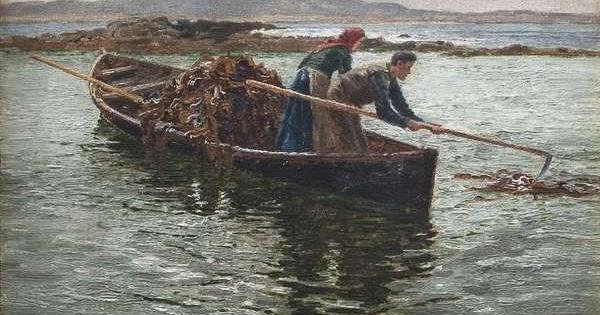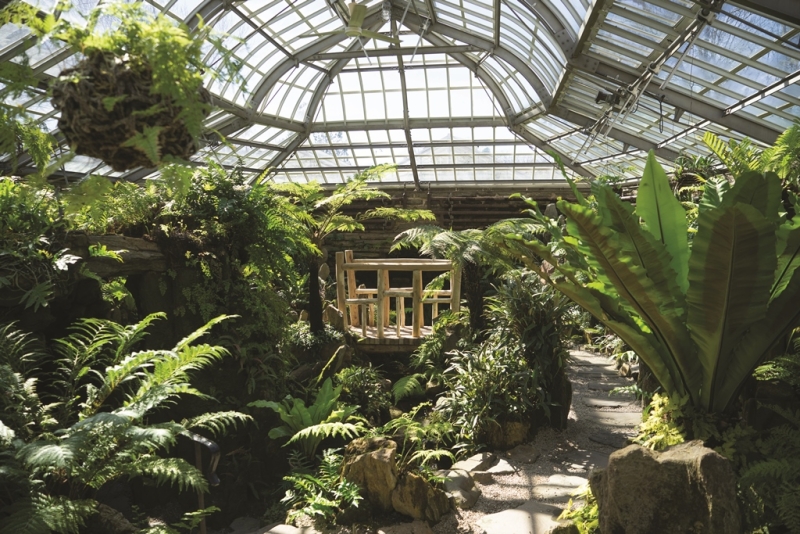Some while ago visiting gardens on the east coast, I came upon a greenhouse that had a piece of seaweed hanging from its cornice. It woke a memory of my childhood in Ireland and staying at bed and breakfast near the sea. The owner would hang a long tendril of seaweed beside the back door as a weather forecaster — it was kelp, Laminaria digitata; long, flat, olive green and rubbery to the touch. In fine weather it would shrink; but would flap fat and flaccid in the breeze if rain was on the way, which in Ireland was a daily given. So how useful it was is dubious, but at least it was almost always correct.

Seaweed of many sorts is important to coastal communities around the world; Ireland being my personal experience I know that ‘dulse’ (Palmaria palmata), ‘carrageenan’, red seaweeds in the Rhodophyceae family is used as a thickening agent in processed foods, and ‘kelp’ is dried and sold as ‘kombu’. Collectively they are called sea vegetables, but are used in the manufacture of cosmetics, spa treatments, and – here’s where it matters to us – as fertilizers; dried and applied as a powder or else emulsified for liquid application. Consequently, seaweed supports a lucrative aquaculture industry, especially important Asia, with China being the largest producer.
If you’re looking for a good feed for pot plants, go for seaweed, which is typically available as liquid to be diluted as needed. Kelp meal, however, is great for working into the soil in garden beds around flowers and vegetables. Seaweed and kelp share many of the same benefits, however, providing vitamins and enzymes that support plant health, yielding better crops and disease resistance. As garden fertilizers go, those of us who’ve used fish emulsion know plants love it, but us? Not so much…it’s the smell, which can linger unpleasantly, and you sure wouldn’t want to use it in a greenhouse. Dogs love it, too, as I know from my own foraging duo, who dig down to get at the best soaky bits. So, dried kelp or liquid seaweed fertilizer are a welcome substitute for fish-derived products.

It’s just a short leap of the imagination to connect feeding plants with kelp or seaweed, to growing plants that will not only benefit from the treatment but look like, as one gardener put it, like the seaweed of the garden, i.e., ferns. Yes, folks, although firmly attached to terra firma, most ferns appreciate moisture above and below ground. At no time was this more appreciated than during the heyday of Victorian gardening, when having a fernery outdoors in a dank corner of the garden, or glass fern-case in a shady window…was de rigeur. Glasshouses arrived in the United States in 1737, imported by a wealthy Bostonian. It’s said that George Washington raised pineapples in his Mount Vernon greenhouse. The White House acquired one in 1857. Originally it was intended as public amenity, but visitors kept stealing the plants, so its use was soon limited to the President and his family.

Whether ferns were grown in the White House greenhouse is a question I can’t answer, but 52 years after the White House glasshouse was realized, John Morris began construction in what remains today as the oldest example of Victorian glasshouse fernery in the United States. Located in the Morris Arboretum and dubbed the Dorrance H. Hamilton Fernery for the person who funded its complete restoration in 1999, it houses an exhaustive collection of ferns gathered from all over the world.
An antique volume of garden wisdom, Beeton’s All About Gardening, published in the London in 1871, describes outdoor ferneries as usually being constructed in a shady nook, and damp,”low-lying situations, where they would naturally receive that shade and moisture which agree them: a shady bank, where water can be supplied artificially makes a good fernery.” Materials used in construction of outdoor ferneries included rough blocks of wood, gnarled roots, and blocks of stone; “Let there be no appearance of labouring to produce an effect, but let the whole be as natural as possible.” The author concludes that greenhouse ferneries may be made in pretty much the same manner, only on a smaller scale.

Those of you with a greenhouse may indulge yourself in cultivating a fern collection: the most sea-weedy in appearance would be the Aspleniums, while the easiest to grow are found in the genus Athyrium. For outdoor gardeners where in arid zones where winter is prolonged and freezing temps the norm, it’s comforting to know that there are over 60 fern species native to Colorado.
I think I’ve just found a new addictive plant habit! I best keep some kelp fertilizer handy.
Copyright Ethne Clarke, 2023


